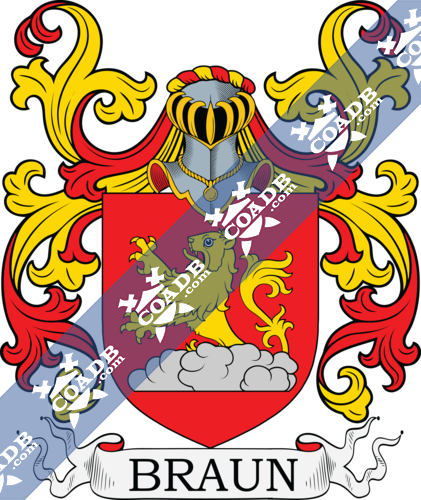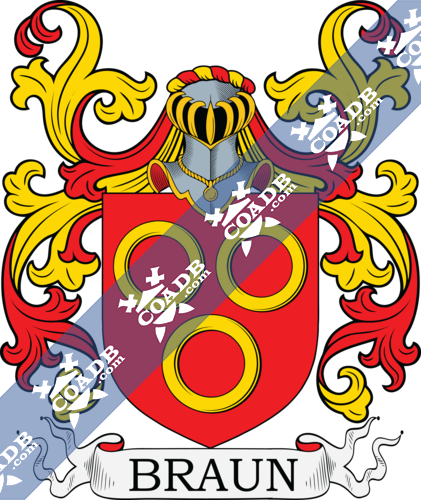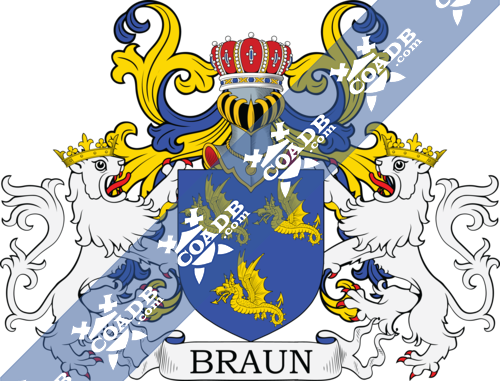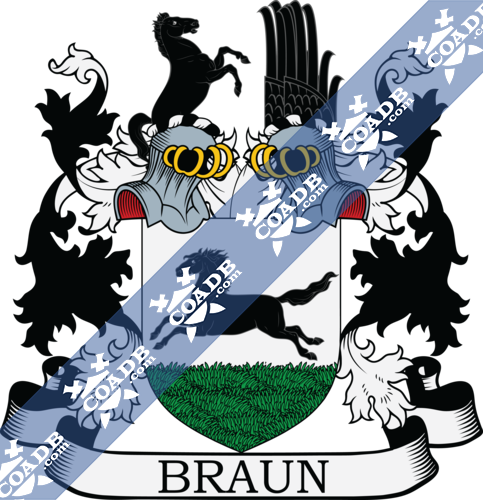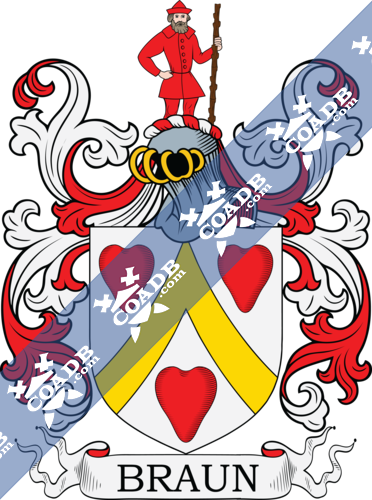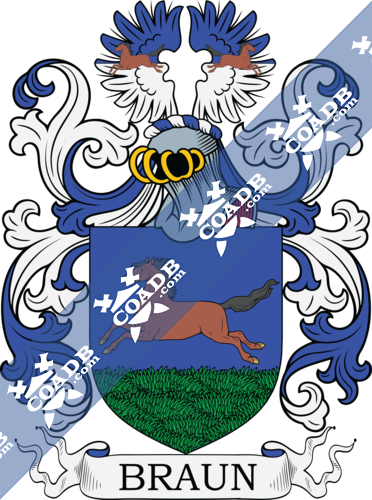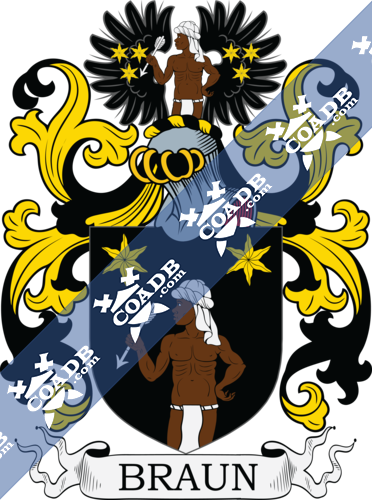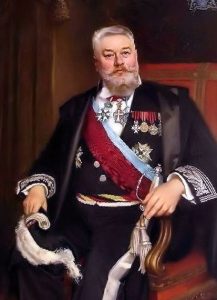Braun Family Crest, Coat of Arms and Name History
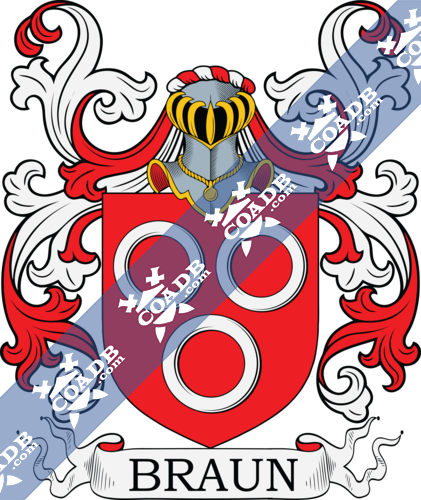
Braun Coat of Arms Gallery
Don’t know which Coat of Arms is yours?
We can do a genealogical research. Find out the exact history of your family!
Learn MoreSurname Name Meaning, Origin, and Etymology
This is a German and Jewish surname refers to a person who was brown, either in eye color, hair color, or beard color. It comes from the German word braun or the Middle High German word brun, both meaning brown. It derives from the Lower German word Bruns, meaning Bruno’s son. Bruno was an ancient personal (first) name. The name was born by the Dukes of Saxony in the 1100s AD (ex Brunp also called Brun or Braun, who was Duke of Saxony in 866 AD and was a member of the Ottonian dynasty). The name was borne by many Catholic saints, and was popularized as such, such as St. Bruno of Cologne (1030-1101 AD) who was founded of the Carthusian Order (religious order of enclosed monastics) and a personal advisor to Pope Urban II. The male given name Bruno derives from the Germanic word brun, meaning armor or shield.
Another source states it derives from the Norse and Anglo-Saxon first name Brando, which itself is a shortened version of the personal name Hildebrand. In this origin theory, it related to the name Brand or Brandt, and the word brand means sword or fire-brand.
Thirdly, it is also possible be that it could refer to a person from a variety of locations bearing this name, such as Branau in Silesia, Saxony, and Bohemia. One source states the name was first found in Saxony by the North Sea or the city of Baden.
Spelling Variations
Common variants include Braune, Brauner (Upper Germany-Silesia), Brauns (Lower Germany, Dortmund, Hanover, Maddeburg). Other variants are Braunes, Braunn, Bront, Bronn, and Bronne Interestingly, the name is often mispronounced as “brawn”.
It should be noted that many German and Austrian immigrants who came to American in the eighteenth and nineteenth centuries change the spelling to Brown. This Anglicized or Americanized spelling is very popular, as it was not only adopted by the Germans, but it one of the top five most common names for people of English, Irish, and Scottish descent or ancestry.
Popularity & Geographic Distribution
The last name ranks Braun ranks 973rd in popularity in the United Status as of the 2000 Census. In the same census, Braunstein ranks 13,825th, Brauner ranks 19,759th, Eisenbraun ranks 30,984th, Braund ranks 36,764th, Braunschweig ranks 40,402nd, Braune ranks 49,970th, Brauns ranks 55,617th, and Brauning ranks 61,626th. There are several other surnames containing the word Braun in them in the United States. The name ranks highest in the following five states: North Dakota, Wisconsin, Minnesota, South Dakota, Nebraska, and Illinois. The name is also popular in other English speaking nations: Canada (643rd), England (4,335th), Australia (2,297th), and New Zealand (4,459th). It is one of the most common surnames in Germany, where it ranks 14th. It is also common in other European countries: Austria (109th), Switzerland (95th), and Belgium (1,609th).
Early Bearers of the Surname
A one Peter Braunbart was documented near Prague in 1378 AD. Brunehannos and Brunenitsche were recorded in Breslau in the 1300s AD. Ulrich Brune was recorded in 1329 AD in Wurttemberg. A one Hamo Braund was found in the Curia Regis Rolls of Bedfordshire.
History, Genealogy, and Ancestry
Hans Jacon Braun was born in 1639 in Most, Sachsen-Anhalt, Germany. He married Anna (last name not known) and later Catherine Tuck. He left behind one issue: a son named Johan Jackob. Johan was born in 1681 in Hintersasse, Germany. In 1701, he married Verena Agnes and had three issue with her: Johann Stephen Christian, Maria Catherina, and Abraham. Johann Stephen Braun was born in 1703 in Niedermohr, Rheinland-Pfalz and he married Maria Eva Hamen in 1730. He left numerous issue with her: Johan Jakob, Johann Michael, Christina Elizabeth, Maria Catherina, Anna Christina, Abraham, Susanna, Andreas, and Mariah Margaretha. His son Johann Michael Braun (or Brown) was born in Ruschberg in 1732. He married three times: Margareta Catereni Shamback, Rosanna Fischer, and Eleanor Wakefield. He had the following children prior to his 1807 death in North Carolina: Christina (Braun) Eckhols, David Brown, John Brown, Peter Brown, Margaret Braun, Hannah (Braun) Motsinger, David Brown, James Brown, Michael Brown, Susannah Braun, Jeremiah Brown, John Brown, Moses Brown, Peter Brown, Michael L Brown and Susan Clementine Brown. He bore an arms with a lion rampant on an azure shield.
Johhannes Peter Braun was born in 1510 in Germany. He had a son named Johann who was born in 1530 in Wald, Bayern. He had a son named Petrus Hubert who was born in 1574 in the same town. He married Petronella Wilhelmina Otten and had a son with her named Hans Valentin Braun. He was born in 1605 in Ormesheim. He married Elizabetha Weidenback in 1640 and had two issue with her: Johannes and Matthias. His son Johann was born in 1625 and married Maria Fritisch. They had two issue: Johann Mathias and Johann Valentin Braun. His son Johann Mathias was born in 1665 and married Maria Anna Katharine Morscholz. They had five children together prior to his 1740 death in Dudweiler: Catharina Margaretha, Elisabeth Maria, Johann Nickel, Johann Marias, and Maria Maguerithe.
Early American and New World Settlers
Early settlers in Colonial America include Hans Braun (1662), Marritje Hendricks Braun (New York 1662), Samuel Braun (Maryland 1679), Johannes Braun (1708), and Paulus Braun (New Jersey 1709). One of the earliest settlers in Canada with this name was Joseph Braun (Quebec 1851. Four persons bearing this last name went to Auckland, New Zealand in 1864 aboard a ship named Steinwarder: Wilhem, Henrietta, Anna, and Louis Braun.
Grantees
We have 28 coats of arms for the Braun surname depicted here. These 28 heraldic blazons are from the famed Dutch genealogist Johann Rietstap’s influential and authoritative work The Armorial General that was published in 1861. The bottom of this page contains the blazons (in the original French and translated in English), and in many instances contains some historical, geographical, and genealogical about where coat of arms was found and who bore it.
Notables
Famous people with this last name include: 1) Alexander Braun (1805-1877) who was a German botanist whose research focused on morphology, 2) Baron Emile Braun (1849=1927) who was a Belgian politican who became the Mayor of Ghent, 3) Otto Braun (1872-1955) who was a politician in the German Social Democratic party and became Prime Minister of Prussia but was later exiled to Switzerland, 4) Werner Magnus Maximilian Freiherr von Braun (1912-1977) who was a German engineer and scientist who came to America and was pivotal in the development of rockets, 5) Maurice Braun (1877-1941) who was an American artist known for Impressionist landscapes, 6) Sanford Braun (1935) who was better known as Sandy Koufax who was a pitcher in Major League Baseball for the Brooklyn/Los Angeles Dodgers, and 7) Matthias Bernard Braun (1684-173) who was a Czechoslovakian sculptor known for his baroque style.
Blazons & Genealogy Notes
1) Gand – (Conc. de nob. et du titre de baron; 2o février 1922) – D’azur à trois dragons volants d’or Pour le porteur du titre couronne de baron et supports deux lions d’argent couronnés d’or armés et lampassés de gueules Pour les autres descendants Heaume couronné Cimier un dragon de l’écu Devise PAX ET LABOR. English: Azure three dragons volant or (for the holder of the title) Crowned with a Baron’s crown Supporters: two lions argent crowned or armed and langued gules (for the other descendents) Crowned with a helmet Crest: a dragon of the shield.
2) Leipzig – D’argent à une branche de peuplier de sinople en barre Cimier un bras paré d’argent la main de carnation tenant la branche en barre. English: Argent a branch of a poplar tree vert in fess Crest: an arm sleeved argent the hand carnation holding the branch in bend sinister.
3) Nördlingen (Bavière) – Tranché au 1 d’argent au lion de gueules au 2 de gueules à un triangle d’argent Cimier le lion issant. English: Per bend 1st argent a lion gules 2nd gules a triangle argent Crest: the lion issuant.
4) France – Coupé au 1 d’argent à un fort ruiné de sable à senestre à dextre d’un lévrier et senestré d’un lion tous deux d’azur et contre-rampants le lion armé d’une épée de sable au 2 d’azur au dextrochère armé d’argent tenant une épée d’argent garnie d’or. English: Per fess 1st argent a ruined castle sable to either side of a greyhound and having to the sinister a lion both azure and counter-rampant, the lion armed with a sword sable 2nd azure an armoured right arm argent holding a sword argent hilt and pommell or.
5) Coire – D’azur à une aigle de sable soutenue d’une terrasse de sinople de laquelle s’élèvent trois flammes de gueules deux près des flancs et une sur le devant ladite aigle fixant un soleil d’or mouv du canton dextre du chef Cimier une aigle de sable Lambrequin d’or et d’azur. English: Azure an eagle sable supported by a mount vert from which rise three flames gules two near the flanks and one under the aforementioned eagle [setting] a sun or coming from the dexter chief quarter Crest: an eagle sable Mantling: or and azure.
6) Coire – De gueules à une branche de buis feuillée de cinq pièces sur une terrasse le tout d’or. English: Gules a branch of a box tree with five leaves on a mount all or.
7) Edle von egg – Autriche – (An., 12 juin 1790) – Coupé d’azur sur argent à une fasce vivrée de brochant sur le coupé et acc en chef de trois étoiles d’argent rangées en fasce et en pointe de trois annelets de sable rangés en fasce Casque couronné Cimier un cerf issant d’argent ayant entre sa ramure une étoile du même Lambrequin à dextre d’argent et d’azur à senestre d’argent et de sable. English: Per fess azure over argent a fess vivre [like dancetty, but with right angles] covering over the partition and surrounded by in chief three etoiles argent in fess and in base by three annulets sable in fess Crowned with a helmet Crest: a stag issuant argent having between its antlers an etoile of the same Mantling: to the dexter argent and azure to the sinister argent and sable.
8) Saxe – Parti au 1 d’argent à la demi-aigle de sable couronnée d’or mouv du parti au 2 palé d’or et de gueules Trois casques couronnés Cimiers 1° trois plumes d’autruche une d’argent entre deux de sable 2° une aigle issante de sable couronnée d’or 3° une vol à l’antique d’or et de gueules Lambrequin à dextre d’argent et de sable à senestre d’or et de gueules Supports deux lions d’or lampassés de gueules Devise RECTE ET CONSTANTER. English: Per pale 1st argent a demi-wing sable crowned or coming from the partition 2nd paly or and gules Crowned with three helmets Crest: 1st three ostrich feathers, one argent between two sable 2nd an eagle issuant sable crowned or 3rd aand ancient pair of wings [see slack] or and gules Mantling: to the dexter argent and sable to the sinister or and gules Supporters: two lions or langued gules.
9) Strasbourg – De gueules à trois annelets d’or. English: Gules three annulets or.
10) Thuringe – Écartelé aux 1 et 4 d’azur à trois étoiles d’or rangées en pal aux 2 et 3 de gueules à trois bandes d’argent Casque couronné Cimier un vol l’aile dextre aux armes du 1 la senestre aux armes du 2 Lambrequin conformes aux émaux du vol (Barons du St-Empire 3 avril 1764) Les mêmes armes Sur le tout d’argent au lion au naturel Trois casques couronnés Cimiers 1° le lion issant et contourné 2° le vol des armes de famille 3° cinq plumes de héron au naturel Lambrequin à dextre d’or et d’azur à senestre d’argent et de gueules Supports deux lions regardants au naturel armés et lampassés de gueules. English: Quarterly 1st & 4th azure three etoiles or in pale 2nd & 3rd gules three bendlets argent Crowned with a helmet Crest: a pair of wings the wing to the dexter with the arms of the 1st, the sinister with the arms of the second Mantling: the same as the wings (alternatively ) the same arms overall an escutcheon argent a lion proper Crowned with three helmets Crest: 1st the lion issuant and reversed 2nd the pair of wings with the arms of the family 3rd five heron feathers proper Mantling: to the dexter or and azure to the sinister argent and gules Supporters: two lions reguardant proper armd and langued gules.
11) Reichenau (Saxe) – (Conc. d’arm., 10 avril 1628) – De gueules à une licorne saillante d’argent crinée d’or soutenue d’un tertre de sinople Cimier la licorne issante entre deux cornes de buffle coupées alternativement de gueules et d’argent. English: Gules a unicorn salient argent crined [mane] or on a hilloc vert Crest: the unicorn issuant between two buffalo horns per fess alternately gules and argent.
12) Nuremberg – D’argent au chevron ployé d’or acc de trois coeurs de gueules Cimier un homme issant par les genoux habillé et coiffé de gueules tenant de sa main dextre étendue un bâton Lambrequin d’argent et de gueules. English: Argent a chevron curved [curving upwards to a point] or surrounded by three hearts gules Crest: a man issuant from the knees dressed and with a hat gules holding in his sinister extended hand a ragged staff Mantling: argent and gules.
13) Poméranie – (Rec. de nob., 2 janv. 1588) – Parti au 1 d’argent à trois barres d’azur au 2 d’azur à deux étoiles d’or l’une sur l’autre Bourlet d’azur et d’argent Cimier une étoile d’or entre deux proboscides coupées alternativement d’argent et d’azur Lambrequin d’argent et d’azur. English: Per pale 1st argent three bendlets sinister azure 2nd azure two etoiles or in pale Crowned with a helmet with a wreath of azure and argent Crest: an etoile between two proboscides per fess alternately argent and azure Mantling: argent and azure.
14) Prusse – (An., 16 juin 1871,) – Parti au 1 d’argent à un ours brunâtre rampant au 2 d’azur à une ancre d’or accostée de deux étoiles du même Cimier un panache de cinq plumes d’autruche de sable d’azur d’or et de sable ledit panache ch de la Croix de fer Lambrequin à dextre d’argent et de sable à senestre d’or et d’azur. English: Per pale 1st argent a bear brunatre rampant 2nd azure a anchor or surrounded by two etoiles of the same Crest: a plume of five ostrich feathers sable, azure, or, and sable the aforementioned plume charged with the iron cross Mantling: to the dexter argent and sable to the sinister or and azure.
15) Allemagne – Écartelé aux 1 et 4 de gueules au bouquetin naissant d’or mouv d’un tertre de sable celui du 1 contourné aux 2 et 3 d’argent à un tertre de sable surmonté d’une rose de gueules Casque couronné Cimier un bouquetin issant de sable entre deux proboscides coupées à dextre de gueules sur argent à senestre d’argent sur sable Lambrequin à dextre d’argent et de sable à senestre d’argent et de gueules. English: Quarterly 1st & 4th gules an ibex [mountain goat] naissant or coming from a hillock sable that on the 1st reversed 2nd & 3rd argent a hillock sable surmounted by a rose gules Crowned with a helmet Crest: an ibex issuant sable between two proboscides per fess to the dexter gules over argent to the sinister argent over sable Mantling: to the dexter argent and sable to the sinister argent and gules.
16) Allemagne – Écartelé aux 1 et 4 d’or à la bande de sable ch d’une rose tigée et feuillée d’or posée dans le sens de la bande aux 2 et 3 coupé de gueules sur argent à un B de l’un en l’autre Sur le tout parti d’argent et de gueules à une étoile de l’un en l’autre Sur le tout parti d’argent et de gueules à une étoile de l’un en l’autre Casque couronné Cimier une étoile d’or entre un vol l’aile dextre aux armes du 2 l’aile senestre aux armes du 1 (la bande transformée en barre) Lambrequin d’or et de sable. English: Quarterly 1st & 4th or a bend sable charged with a rose stemmed and leaved or place in bend 2nd & 3rd per fess gules over argent and a letter ‘B’ counterchanged overall an escutcheon per pale argent and gules a etoiles counterchanged Crowned with a helmet Crest: an etoile or between a pair of wings the wing to the dexter with the arms of the 2nd the wing to the sinister with the arms of the 1st (the bend turned into bend sinister) Mantling: or and sable.
17) Alsace – (Petit vitrail du XVIIe siècle conservé au musée de Besançon) – De gueules à trois annelets d’argent posés 2 et 1. English: Gules three annulets argent 2 and 1.
18) Allemagne – Écartelé aux 1 et 4 d’argent à la licorne saillante au naturel celle du 1 contournée aux 2 et 3 d’azur à la bande d’argent ch de trois roses de gueules Casque couronné Cimier une licorne issante au naturel entre un vol d’argent Supports deux lions regardants. English: Quarterly 1st & 4th argent a unicorn salient proper that on the first reversed 2nd & 3rd azure a bne argent charged with three roses gules Crowned with a helmet Crest: a unicorn issuant proper between a pair of wings argent Supporters: two lions reguardant.
19) (Edle von) – Bavière, Saxe, Wurtemberg – (An., 31 mars 1808) – Écartelé d’azur et d’argent Sur le tout d’or à une branche de chêne effeuillée de cinq pièces au naturel Cimier la branche entre un vol coupé alternativement d’argent et d’azur Lambrequin des deux derniers émaux. English: Quartered azure and argent overall an escutcheon or a branch of oak leaved with five pieces proper Crest: the branch between a pair of wings per fess alternately argent and azure Mantling: the two previous colours.
20) Allemagne – D’azur à un cheval bai échappé sur une terrasse de sinople Cimier un vol coupé d’azur sur argent chaque aile ch du cheval de l’écu celui sur l’aile senestre contourné Lambrequin d’argent et d’azur. English: Azure a bay horse breaking away on a mount vert Crest: a pair of wings per fess azure over argent each wing charged with the horse of the shield that on the sinister wing reversed Mantling: argent and azure.
21) Allemagne – De sable à deux étoiles d’or rangées en fasce à une pile évasée d’or ch d’un trèfle de sable Casque couronné Cimier le trèfle entre un vol de sable chaque aile ch d’une étoile d’or. English: Sable two etoiles in fess a pile opening out at the top [curved I suppose] or charged with a trefoil sable Crowned with a helmet Crest: the trefoil between a pair of wings sable each wing charged with etoile or.
22) Bavière – (An., 23 avril 1813) – De gueules au lion d’or tenant un sabre d’argent et soutenu d’un tertre de sinople Casque couronné Cimier une Fortune de carnation posée sur une roue d’argent et tenant un voile d’azur. English: Gules a lion or holding a sabre argent on a hillock vert Crowned with a helmet Crest: a Fortune [Lady Luck?] carnation placed on a wheel argent and holding a sail azure.
23) Breslau – (An., 1507) – De gueules à un lion d’or issant de nuées au naturel. English: Gules a lion or issuant from a cloud proper.
24) Chevaliers de Praun – Bohême – (Chevaliers, 9 août 1553) – Coupé au 1 d’or à un More issant mouv du coupé tenant de sa main dextre un phéon prêt à être lancé la main senestre appuyée sur sa hanche au 2 d’azur à une fleur-de-lis d’argent Cimier le More issant entre deux proboscides coupées à dextre d’argent sur azur à senestre d’or sur sable Lambrequin conformes aux émaux des proboscides. English: Per fess 1st a Moor issuant coming from the partition holding in his dexter hand a pheon [spear head] about to be launched the sinister hand resting on the hip 2nd azure a fleur-de-lys argent Crest: the Moor issuant between two proboscides per fess to the dexter argent over azure to the sinister or over sable Mantling: the same tinctures as the proboscides.
25) Bavière – (An., 12 avril 1767) – De sable à un More issant au naturel posé de profil tortillé d’argent ceint d’un tablier du même tenant de sa main dextre levée une flèche d’argent en barre la pointe en bas ledit More acc en chef de deux étoiles d’or Casque couronné Cimier le More issant entre un vol de sable chaque aile ch de trois étoiles d’or Lambrequin d’or et de sable. English: Sable a Moor issuant proper in profile turbaned argent belted with a smock of the same holding in his raised dexter hand an arrow argent in bend sinister the point downwards the aforementioned Moor accompanied by in chief two etoiles or Crowned with a helmet Crest: the Moor issuant between a pair of wings sable each wing charged with three etoiles or Mantling: or and sable.
26) Anhalt-Bernburg – (An., 30 août 1830) – Coupé au 1 d’argent à trois têtes de cheval de couleur brunâtre mal-ordonnées au 2 de sable à trois pals de pourpre bordés d’or Bourlet de sable ch de trois pals pareils à ceux du 2 Cimier une tête de cheval du 1 entre un vol aux armes du 2 Lambrequin d’or et de pourpre Devise EDEL DURCH ART. English: Per fess 1st argent three horses heads brunatre disordered [1 and 2] 2nd sable three palets purpure fimbriated or Crowned with a helmet with a wreath sable charged with three palets similar to those of the 2nd Crest: a horses head of the 1st between a pair of wings with the arms of the 2nd Mantling: or and purpure.
27) Bade – (Chevaliers du St.-Empire, 1 juin 1801) – D’argent au cheval de sable galopant sur une terrasse de sinople Deux casques couronnés Cimiers 1° un cheval issant et contourné de sable 2° un vol à l’antique de sable Lambrequin d’argent et de sable. English: Argent a horse sable galopant on a mount vert Crowned with two helmets Crest: 1st a horse issuant and reversed sable 2nd an ancient pair of wings sable Mantling: argent and sable.
28) Bâle – D’or à trois trèfles mouv d’une même tige issants d’un tertre de trois coupeaux le tout de sinople Cimier les meubles de l’écu Lambrequin d’or et de sable. English: Or three trefoils coming from the same stem issuant from a hillock of three peaks all vert Crest: the charges of the shield Mantling: or and sable.

